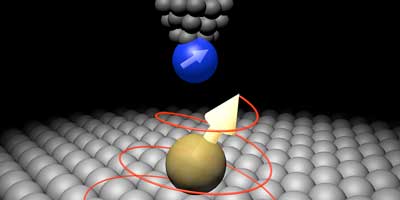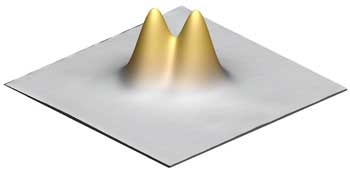| Oct 24, 2019 | |
Building single-atom qubits under a microscope(Nanowerk News) Scientists at IBM Research made a breakthrough in controlling the quantum behavior of individual atoms, demonstrating a versatile new building block for quantum computation. |
|
| In a paper published in the journal Science ("Coherent spin manipulation of individual atoms on a surface"), our team demonstrated the use of single atoms as qubits for quantum information processing. Quantum bits, or qubits, are the fundamental building blocks of a quantum computer’s ability to process information. | |
| This is the first time a single-atom qubit has been achieved using a Scanning Tunneling Microscope (STM), the Nobel Prize-winning IBM invention that allows atoms to be viewed and moved individually. This is an important breakthrough because the STM can image and position each atomic qubit to precisely control the arrangement of nearby qubit atoms. The microscope works by scanning the ultra-sharp needle tip near a surface to sense the arrangement of individual atoms, and the needle tip can pull or carry atoms into desired arrangements. | |
A quantum leap from atomic bit to qubit |
|
| The basic unit of information in our current computers is a bit. A bit can have only one of two values: “0” or “1.” The quantum cousin of bit is a qubit, which powers a quantum computer. In addition to having “0” and “1” values, a qubit can also be in a combination of “0” and “1” simultaneously. This kind of state—partly “0” and partly “1”—is called a superposition state. Such states are a fundamental characteristic of quantum mechanics that has been known for decades and is only recently being put to use in real quantum computers. | |
| In our experiments, we use a quantum property of a titanium atom called “spin” to represent one qubit. The spin property makes each titanium magnetic, so it behaves like a tiny compass needle. Like a magnet on a refrigerator, each titanium atom has a north and south magnetic pole. The two magnetic orientations define the “0” or “1” of a qubit. We placed the titanium atom on a specially chosen surface, an ultra-thin layer of magnesium oxide, to protect its magnetism and allow it to show off its quantum personality. | |
Teaching a titanium atom to dance |
|
| So, how can we coax a titanium atom into a chosen quantum superposition state? The answer is to apply high-frequency radio waves, called microwaves, to the atom. These microwaves, emanating from the microscope’s tip, steer the atom’s magnetic direction. When tuned to the right frequency, these microwaves lead the titanium atom to perform a “quantum dance,” as shown in the figure below. The atom holds still on the surface, but its magnetic north pole rapidly spirals around, ending in the desired direction. | |
| This dance, called “Rabi oscillation,” is extremely fast, taking only about 20 nanoseconds to turn the qubit around, from pointing up to “0,” to pointing down to “1” or back again. At the end of the dance, the atom points to a designed direction—a “0” or a “1” or a superposition that lies in between—depending how long we apply the radio waves. | |
| The technical term of this key technique is pulsed electron spin resonance, and it can create any supposition state we want. We control and observe these spin rotations using the STM’s extreme sensitivity. | |
 |
|
| Figure 1 An artist’s view of the quantum dance of a single titanium atom (yellow ball) sitting atop a specially prepared surface of magnesium oxide. The top of the image shows the STM’s sharp needle tip, which is used to perform coherent control. (Image: IBM Research) | |
| These single-atom qubits are extremely sensitive to magnetic fields so they can also be used as quantum sensors to measure the subtle magnetism of nearby atoms. We used this sensitivity to make qubits interact – or entangle – with each other and make a two-qubit device. This is a critical step toward the understanding of how to accomplish the ultimate goal of having many qubits interact so that we can take advantage of the quantum speedup in the processing power over conventional computers. | |
| To build a two-qubit device, we employ our microscope to see and literally touch individual titanium atoms, nudging them precisely into desired atomic positions. This allows us to build engineered structures consisting of two atoms at precisely chosen spacings, as shown in the figure below. | |
 |
|
| Figure 2. An image of two titanium atoms positioned just 1 nanometer apart and used to perform complex quantum operations. (Image: IBM Research) | |
| When we put two fridge magnets together, they either attract or repel depending on how they are held. Similar physics holds for the two titanium atoms on this surface, and the tiny magnetic force between them aligns them, so they point in opposite directions. The technical term for this magnetic force between the two atoms is the quantum exchange interaction. | |
| Due to this quantum interaction, the two qubits can form a state having quantum entanglement. Entangled states are quantum patterns in which the state of one qubit is directly related to the state of another — so entwined that it is technically not possible to describe the state of one atom without describing the other at the same time. This property of entanglement is the key to the power of quantum computing. We are able to control the properties of this entanglement by adjusting the distance between the atoms, and by choosing the duration and the frequency of the radio waves that control them. | |
| Controlling quantum superposition and entanglement through pulsed spin resonance are just two examples of what we can now study. For example, as we entangle more atoms, we could test theories about what causes quantum decoherence – where and how does it originate? How can it be reduced? Chemists could test the designs of magnetic molecules and artificial quantum materials. This breakthrough of using pulsed spin resonance on arrangements of atoms gives us an analog quantum simulator to test a host of quantum magnetic properties that could lead to new computing techniques. |
| Source: By Chris Lutz and Kai Yang, IBM Research | |
|
Subscribe to a free copy of one of our daily Nanowerk Newsletter Email Digests with a compilation of all of the day's news. |
